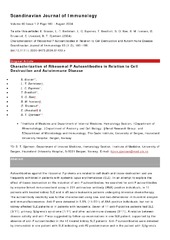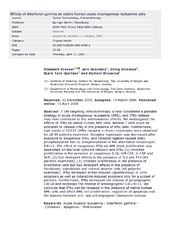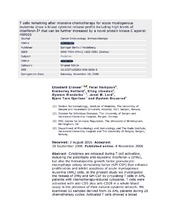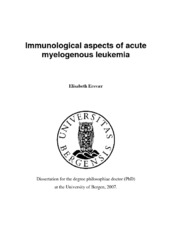| dc.description.abstract | Acute myelogenous leukemia (AML) is an aggressive malignancy characterized by accumulation of immature myeloid cells in the bone marrow. The overall disease-free survival is less than 50% even for the younger patients who can receive the most intensive treatment and hence, there is obviously a need for an improved therapy. Short time until lymphoid reconstitution after chemotherapy seems to be a good prognostic factor in several malignancies, including AML, and targeting of autologous T cells is considered a possible therapeutic approach. Thus, the major aim of this thesis was to further characterize the immune system of patients with AML. Disease and therapy induced T lymphocyte defects may contribute to the immune defects in AML. We therefore characterized the T lymphocytes of untreated AML patients as well as the remaining T cells in AML patients receiving intensive chemotherapy. Untreated AML patients were found to have close to normal lymphocyte subset ratios and also the in vitro T cell activation response, release of IFNγ, was close to normal after adjustment of cell numbers. In contrast, the released levels of IFNγ and GM-CSF cytokines from in vitro activated T cells in whole blood from cytopenia AML patients were lower than for healthy controls. However, the IFNγ and GM-CSF levels could be further increased by the protein kinase C agonist Pep005. The direct effects of the IFNγ on AML blasts included altered i) cytokine-dependent AML cell proliferation, ii) viability, and iii) balance between pro- and antiangiogenic chemokine release. Several mutated or overexpressed proteins seem to be processed and presented to the immune system as tumor antigens leading to humoral and/or cellular responses. Autoantibodies are thus common in cancer patients but the autoantibody response in AML patients has been included in relatively few previous studies. Our studies report aberrant cyclin B1 expression in primary AML cells and detection of anti-cyclin B1 in a subset of sera from AML patients. In contrast, no autoantibodies against the typically SLE associated antigen P-protein could be detected in sera from untreated and chemotherapy treated AML patients. To conclude, both the cellular and humoral immune system in AML patients differ from healthy controls. However, our results support the hypothesis that even these immunocompromized patients have remaining immunocompetent cells that can be targeted by immunotherapy. | en_US |





